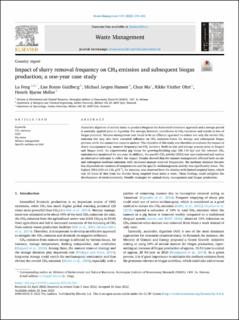| dc.contributor.author | Feng, Lu | |
| dc.contributor.author | Guldberg, Lise Bonne | |
| dc.contributor.author | Hansen, Michael Jørgen | |
| dc.contributor.author | Ma, Chun | |
| dc.contributor.author | Ohrt, Rikke Vinther | |
| dc.contributor.author | Møller, Henrik Bjarne | |
| dc.date.accessioned | 2022-10-20T14:36:57Z | |
| dc.date.available | 2022-10-20T14:36:57Z | |
| dc.date.created | 2022-06-22T21:30:25Z | |
| dc.date.issued | 2022-06-22 | |
| dc.identifier.citation | Waste Management. 2022, 149 199-206. | en_US |
| dc.identifier.issn | 0956-053X | |
| dc.identifier.uri | https://hdl.handle.net/11250/3027373 | |
| dc.description.abstract | Anaerobic digestion of animal slurry to produce biogas is the dominated treatment approach and a storage period is normally applied prior to digestion. Pre-storage, however, contributes to CH4 emissions and results in loss of biogas potential. Manure management was found to be an efficient approach to reduce not only the on-site CH4 emission but may also have extended influence on CH4 emission/losses for storage and subsequent biogas process, while the connection remains unclear. The objective of this study was therefore to evaluate the impact of slurry management (e.g. removal frequency) on CH4 emission (both on-site and storage process prior to biogas) and biogas yield. An experimental pig house for growing-finishing pigs (30–110 kg) and the relevant CH4 emission was monitored for one year. In addition, the specific CH4 activity (SMA) test was conducted and used as an alternative indicator to reflect the impact. Results showed that the manure management affected both on-site and subsequent methane emission; with increased manure removal frequencies, the methane emission became less dependent on variation of temperatures and the specific methanogenesis activity was significantly lower. The highest SMA (100 mL CH4 gVS-1), for instance, was observed from the slurries with limited emptied times, which was 10 times of that from the slurries being emptied three times a week. These findings could enlighten the development of environmentally friendly strategies for animal slurry management and biogas production. | en_US |
| dc.language.iso | eng | en_US |
| dc.publisher | Elsevier Ltd. | en_US |
| dc.rights | Navngivelse 4.0 Internasjonal | * |
| dc.rights.uri | http://creativecommons.org/licenses/by/4.0/deed.no | * |
| dc.title | Impact of slurry removal frequency on CH4 emission and subsequent biogas production; a one-year case study | en_US |
| dc.title.alternative | Impact of slurry removal frequency on CH4 emission and subsequent biogas production; a one-year case study | en_US |
| dc.type | Peer reviewed | en_US |
| dc.type | Journal article | en_US |
| dc.description.version | publishedVersion | en_US |
| dc.rights.holder | © 2022 The Authors | en_US |
| dc.source.pagenumber | 199-206 | en_US |
| dc.source.volume | 149 | en_US |
| dc.source.journal | Waste Management | en_US |
| dc.identifier.doi | 10.1016/j.wasman.2022.06.024 | |
| dc.identifier.cristin | 2034380 | |
| cristin.ispublished | true | |
| cristin.fulltext | original | |
| cristin.qualitycode | 1 | |

